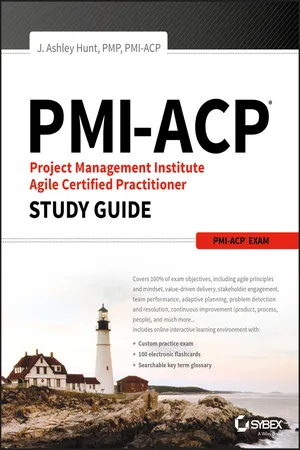
PMI-ACP Project Management Institute Agile Certified Practitioner Exam Study Guide
J. Ashley Hunt
- English
- ePUB (apto para móviles)
- Disponible en iOS y Android
PMI-ACP Project Management Institute Agile Certified Practitioner Exam Study Guide
J. Ashley Hunt
Información del libro
The ultimate study package for the new PMI-ACP exam
The PMI-ACP Project Management Institute Agile Certified Practitioner Exam Study Guide is an all-in-one package for comprehensive exam preparation. This up-to-date guide is fully aligned with the latest version of the exam, featuring coverage of 100 percent of the exam domains. Expanded coverage of AGILE includes the basic principles, value-driven delivery, stakeholder engagement, team performance, adaptive planning, problem detection and resolution, and continuous improvement to align with the A Guide to the Project Management Body of Knowledge (PMBOK® 6 th Edition) and its increased emphasis on agile, adaptive and iterative practices.
In-depth discussion merges with hands-on exercises and real-world scenarios to provide a well-rounded review of essential exam concepts, while the online learning center provides an assessment test, chapter tests, a practice exam, and study aids to help you ensure complete preparation for the big day.
- Master 100 percent of the exam objectives, including expanded AGILE coverage
- Reinforce critical concepts with hands-on practice and real-world scenarios
- Test your knowledge with challenging chapter review questions
- One year of FREE access to the Sybex online test bank featuring practice tests, flashcards, a glossary, and more
Project management is one of the most in-demand skills in today's job market, making more and more employers turn to AGILE methodologies to enhance delivery and results. The PMI-ACP certification shows employers that you have demonstrated mastery of essential project management skills and a practical understanding of adaptive, iterative processes; this validation puts you among the ranks of qualified project management professionals employers are desperately seeking, and the PMI-ACP Project Management Institute Agile Certified Practitioner Exam Study Guide is your one-stop resource for exam success.
Preguntas frecuentes
Información
Chapter 1
Agile Foundations
- Task 1: Advocate for agile principles by modeling those principles and discussing agile values in order to develop a shared mindset across the team as well as between the customer and the team.
- Task 2: Help ensure that everyone has a common understanding of the values and principles of agile and a common knowledge around the agile practices and terminology being used in order to work effectively.
- Task 3: Support change at the system or organization level by educating the organization and influencing processes, behaviors, and people in order to make the organization more effective and efficient.
- Task 4: Practice visualization by maintaining highly visible information radiators showing real progress and real team performance in order to enhance transparency and trust.
- Task 5: Contribute to a safe and trustful team environment by allowing everyone to experiment and make mistakes so that each can learn and continuously improve the way he or she works.
- Task 6: Enhance creativity by experimenting with new techniques and process ideas in order to discover more efficient and effective ways of working.
- Task 7: Encourage team members to share knowledge by collaborating and working together in order to lower risks around knowledge silos and reduce bottlenecks.
- Task 8: Encourage emergent leadership within the team by establishing a safe and respectful environment in which new approaches can be tried in order to make improvements and foster self-organization and empowerment.
- Task 9: Practice servant leadership by supporting and encouraging others in their endeavors so that they can perform at their highest level and continue to improve.

History and the Agile Manifesto
The Agile Alliance
The Agile Manifesto
The Agile Manifesto forms the basis for most methods currently in use today, including Scrum, eXtreme Programming, Lean, Crystal Methods, and others.